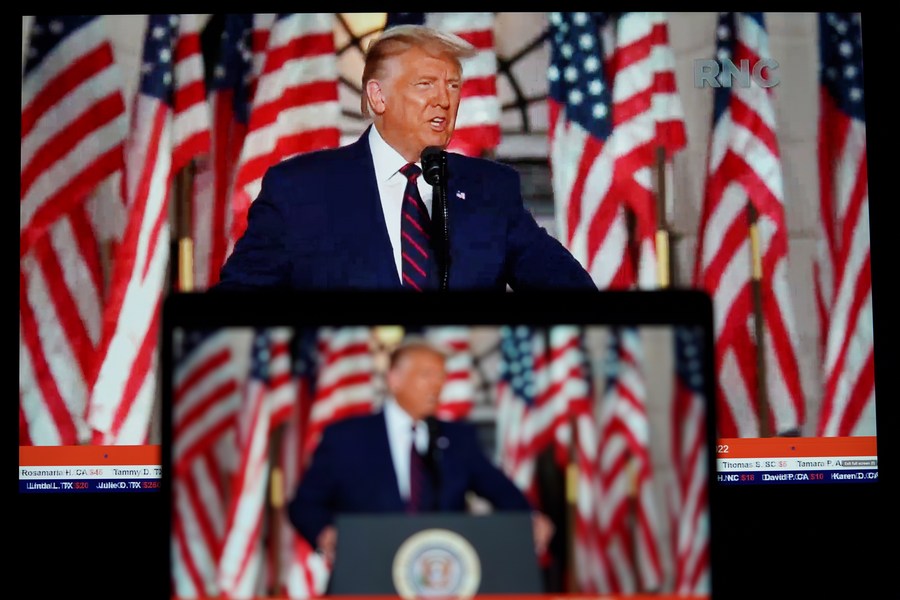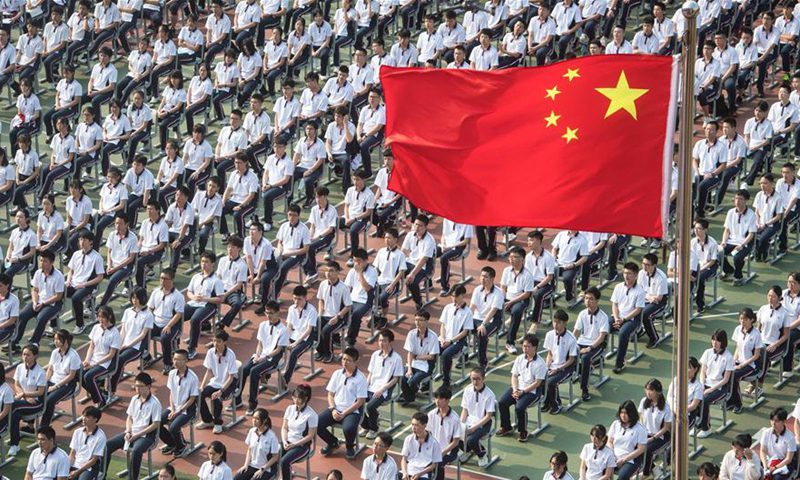


U.S. President Donald Trump delivers his acceptance speech during the 2020 Republican National Convention. (Xinhua/Liu Jie)
US president Donald Trump recently cast doubts over the accuracy of China’s COVID-19 death toll, while continuing to downplay the threat of the virus and turning a blind eye to the climbing casualty numbers domestically, a move that drew a quick backlash at home and abroad.
On Sept. 1, President Donald Trump claimed during an interview with Fox News’s Laura Ingraham that thousands more people have died from the coronavirus in China than the Chinese government has acknowledged. When asked how he knew the number of virus deaths in China, he changed the subject, without citing any evidence, according to a Bloomberg report.
Three days later at a press briefing, Trump touted his accomplishments by repeating his groundless assertion that China had “far more deaths” than the US did, but “China’s not reporting”, adding that the US is “rounding the corner” on the COVID-19 pandemic.
Trump’s remarks came in response to a forecast by IHME at the University of Washington that the US will have 410,000 American deaths from coronavirus by Jan. 1 of next year.
Many were quick to criticize his misleading information. Journalist Bob Woodward revealed in his new book, Rage, that Trump knew COVID-19 was deadlier than the flu before it hit the country but wanted to play down the crisis, US media reported.
When asked by ABC correspondent Jonathan Karl last Thursday, “Why did you lie to the American people?” Trump lashed out at him and deflected the question.
“[Trump] did lie, does lie and he continues to lie,” commented Los Angeles Times.
According to Johns Hopkins University, as of Sept. 14, there were more than 6.52 million diagnosed cases and at least 194,036 deaths in the US, making it the worst-affected country in the world.
While US politicians continue to defame China with lies in order to divert the blame domestically, life in most parts of China has returned to normal. No new locally transmitted COVID-19 cases have been reported across the Chinese mainland, the National Health Commission said last Sunday.
China is now turning its attention to economic recovery, as demonstrated by a number of grand social and economic events. The port city of Qingdao held a beer festival in August that attracted 1.21 million visitors. In early September, about 6,000 companies and institutions from around the world joined the China International Fair for Trade in Service (CIFTIS) held in Beijing, a city where all COVID-19 cases had been cleared by Aug.25, just two months after a new outbreak emerged at a Beijing food market.

Students take part in the opening ceremony of a new semester at Wuhan High School in Wuhan, capital of central China's Hubei Province, Sept. 1, 2020. (Xinhua/Xiao Yijiu)
Even Wuhan, the city that first reported the outbreak, regained its vitality after months of lockdown: schools reopened on Sept. 1, restaurants and parks are packed, and night markets are bustling with life.
As of Thursday, the total number of confirmed COVID-19 cases on the Chinese mainland had reached 85,168; 4,634 had died of the disease, demonstrating a cure rate of over 94 percent.
Behind the achievements in China’s fight against the virus are the determined actions by the Chinese government. Under the Chinese central authorities’ principle of “leaving no patients unattended”, China’s sweeping protection covers all men and women, children, the elderly, the disabled and the poor.
Taking the elderly as an example, more than 3,000 patients over the age of 80, including seven centenarians, have been cured, with many of them brought back from the brink of death, according to a white paper on China’s fight against COVID-19 issued by the State Council Information Office.

 Award-winning photos show poverty reduction achievements in NE China's Jilin province
Award-winning photos show poverty reduction achievements in NE China's Jilin province People dance to greet advent of New Year in Ameiqituo Town, Guizhou
People dance to greet advent of New Year in Ameiqituo Town, Guizhou Fire brigade in Shanghai holds group wedding
Fire brigade in Shanghai holds group wedding Tourists enjoy ice sculptures in Datan Town, north China
Tourists enjoy ice sculptures in Datan Town, north China Sunset scenery of Dayan Pagoda in Xi'an
Sunset scenery of Dayan Pagoda in Xi'an Tourists have fun at scenic spot in Nanlong Town, NW China
Tourists have fun at scenic spot in Nanlong Town, NW China Harbin attracts tourists by making best use of ice in winter
Harbin attracts tourists by making best use of ice in winter In pics: FIS Alpine Ski Women's World Cup Slalom
In pics: FIS Alpine Ski Women's World Cup Slalom Black-necked cranes rest at reservoir in Lhunzhub County, Lhasa
Black-necked cranes rest at reservoir in Lhunzhub County, Lhasa China's FAST telescope will be available to foreign scientists in April
China's FAST telescope will be available to foreign scientists in April